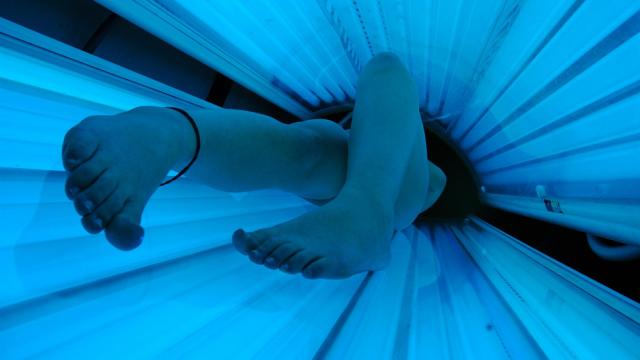The US Food and Drug Administration is proposing that minors be restricted from using tanning beds, and that adults sign a waiver acknowledging the risks. Given similar guidelines elsewhere in the world, and in consideration of the many health risks involved, these measures are long overdue.
Under the proposed guidelines, tanning beds would be outlawed for minors, and individuals over the age of 18 would have to sign a risk acknowledgement certification stating that they have been informed of the risks. And to remind customers about the health risks involved, these waivers must be re-signed every six months.
There’s no question that tanning beds are harmful. The American Academy of Dermatology says that people who have been exposed to UV radiation from indoor tanning are nearly 60% more likely to develop melanoma, a malignant form of skin cancer, than those who don’t tan indoors. Direct exposure to these harmful rays have also been linked to both basal cell and squamous cell cancers, which are the most common forms of skin cancer. They also contribute to eye damage, such as cataracts, and photoaging, which manifests as wrinkles, freckling, and loosening of the skin.
Too much exposure to UV radiation from sunbeds, or the sun for that matter, damages the genetic material in our skin cells. When this DNA damage builds up over time, it can cause our skin cells to grow out of control, potentially leading to skin cancer and other skin problems. Disturbingly, tanning beds not only cause the same type of skin and eye damage as natural sunlight — they’re also as much as 20 times stronger.
Compounding the problem is the fact that exposure to UV radiation is cumulative, so children and teenagers who use tanning beds are at greater risk of developing skin and eye damage later in life. The American Cancer Society says that the “risk of melanoma is higher if the person started indoor tanning before age 30 or 35,” and that the “risk of basal and squamous cell skin cancer is higher if indoor tanning started before age 20 or 25.”
And yes, tanning salons are popular among youth. Data from the 2013 National Youth Risk Behaviour Survey suggests that 1.6 million minors will put themselves in a tanning booth each year. Some 13% of all tanning salon customers are minors.
But it’s not just UV radiation that’s the problem. The Centres for Disease Control and Prevention says that more than 3,000 (!) emergency department room visits occur for injuries related to indoor tanning each year in the United States.
So, it makes sense that the US Food and Drug Administration is finally doing something.
“Today’s action is intended to help protect young people from a known and preventable cause of skin cancer and other harms,” noted acting FDA Commissioner Stephen Ostroff in a press release. “Individuals under 18 years are at greatest risk of the adverse health consequences of indoor tanning.”
Other proposed safety measures include:
- Making warnings easier to read and more prominent on the device
- Requiring an emergency shut off switch, or “panic button”
- Improving eye safety by adding requirements that would limit the amount of light allowed through protective eyewear
- Improving labelling on replacement bulbs so tanning facility operators can make sure they are using the proper replacement bulbs, reducing the risk of accidental burns
- Prohibiting dangerous device modifications, like installing stronger bulbs, without re-certifying and re-identifying the device with the FDA
“The FDA understands that some adults may decide to continue to use sunlamp products,” says Ostroff. “These proposed rules are meant to help adults make their decisions based on truthful information and to ensure manufacturers and tanning facilities take additional steps to improve the safety of these devices.”
Should these measures be approved, it would have quite an effect on the tanning industry. The FDA says there are approximately 18,000 to 19,000 indoor tanning salons and 15,000 to 20,000 related facilities, such as health clubs, spas, and other establishments, that offer tanning services in the US.
Banning minors from tanning salons would not be without precedent. They’re currently off-limits for minors in Brazil, Belgium, the Netherlands, Finland, France, Germany, Spain, Iceland, Norway, Ireland and Lithuania. In Canada, some provinces (and at least one municipality) have already outlawed the use of tanning beds for people under the age of 18, or are at least planning to. The FDA’s guidelines, therefore, seem quite overdue.
[ FDA ]
